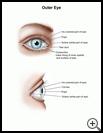
Bleeding in the White of the Eye (Subconjunctival Hemorrhage)
________________________________________________________________________
KEY POINTS
- Subconjunctival hemorrhage means that a small blood vessel breaks on the outside white part of your child’s eye, and makes part of the white of the eye bright red.
- Usually, no treatment is needed. In most cases, the redness in your child’s eye goes away in 1 to 3 weeks. Your child’s provider may suggest using artificial tears eye drops if your child’s eye feels scratchy.
________________________________________________________________________
What is bleeding in the white of the eye?
If a small blood vessel breaks on the outside white part of your eye, the blood makes part of the white of your eye bright red. This is called a subconjunctival hemorrhage. The redness can increase over 24 to 48 hours, especially if you are taking aspirin or blood thinners. Usually, it clears up by itself in a week or two, just like a bruise on the skin does.
What is the cause?
Bleeding in the white of your eye can be caused by injuries, forceful coughing, vomiting, or sneezing, or straining to have a bowel movement. Being on blood thinners such as aspirin or warfarin may increase the risk. However, most of the time, there is no clear cause for the bleeding.
What are the symptoms?
Your child’s eye will be red. Some children have a mild scratchy feeling in the eye. It should not affect your child’s vision.
How is it diagnosed?
Your healthcare provider will ask about your child’s symptoms and examine your child’s eyes. Usually no tests are needed. If it happens to your child a lot, a blood test may be done to check for a bleeding problem.
How is it treated?
Usually, no treatment is needed. In most cases, the redness in your child’s eye goes away in 1 to 3 weeks. Your child’s eye may turn yellow before it turns white again, as the blood is absorbed. Your child’s provider may suggest that your child use artificial tears eye drops if the eye feels scratchy.
How can I take care of my child?
Follow the full course of treatment your healthcare provider prescribes. Ask your healthcare provider:
- How long it will take to recover
- If there are activities your child should avoid and when your child can return to normal activities
- How to take care of your child at home
- What symptoms or problems you should watch for and what to do if your child has them
Make sure you know when your child should come back for a checkup. Keep all appointments for provider visits or tests.
Last modified: 2019-07-15
Last reviewed: 2019-07-15

